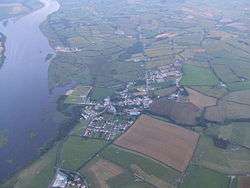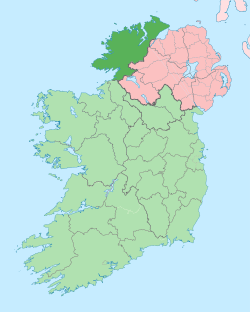St Johnston
| St Johnston Baile Suingean | |
|---|---|
| Village | |
|
Village of St. Johnston | |
 St Johnston Location in Ireland | |
| Coordinates: 54°56′10″N 7°27′42″W / 54.936174°N 7.461569°WCoordinates: 54°56′10″N 7°27′42″W / 54.936174°N 7.461569°W | |
| Country | Ireland |
| Province | Ulster |
| County | County Donegal |
| Government | |
| • Dáil Éireann | Donegal North-East |
| Population (2011)[1] | |
| • Urban | 583 |
| Time zone | WET (UTC+0) |
| • Summer (DST) | IST (WEST) (UTC-1) |
| Website |
www |

St Johnston, officially Saint Johnstown[2] (Irish: Baile Suingean[2]), is a village, townland, and electoral division in County Donegal in Ireland.[2] It is in the Laggan district of East Donegal on the left bank of the River Foyle.[3] It is in the civil parish of Taughboyne and barony of Raphoe North,[2] on the R236 (Lifford–Newtowncunningham) road where it overlaps the R265 (Carrigans– Raphoe) road.[4] The village is about 12 km south of Derry.
Architecture
St. Baithin's Church (popularly known as 'the Chapel'), the Catholic parish church in the village, was designed by E. W. Godwin, the mid-Victorian British architect. It is a neo-Gothic structure that was built between 1857 and 1860.[5]
St. Johnston Presbyterian Church, located on the Derry Road, is the other main structure within the village. Parts of this church may date back to around 1724. However, most of the present neo-Gothic structure was built in the early nineteenth century. The 'thin' neo-Gothic tower was built in 1849.[6] This church, which is owned by the Presbyterian Church in Ireland, was severely damaged by a lightning strike in the mid-1980s. The tower of the church was particularly damaged. The building, however, which serves the large Ulster Scots Presbyterian community in this part of The Laggan, had been fully restored by around 1990.
History
Mongavlin Castle (also known as Mongevlin Castle),[7] a ruined castle, approx 3 km south of the town. It was once a stronghold of the O'Donnells, Lords of Tyrconnell. In the sixteenth century Mongevlin was the chief residence of Ineen Dubh, the daughter of MacDonnell, Lord of the Isles and mother of Red Hugh O'Donnell. When Ineen Dubh came to Ireland to marry Aodh mac Maghnusa Ó Domhnaill, she brought a force of 100 of the biggest men she could find in Scotland for protection. 80 of these were of the name Crawford. When Mongavlin was eventually abandoned, the Crawfords settled and married in the locality. Many of their descendants can still be found in the area to this day.
On 23 July 1610, Mongevlin Castle and its lands were granted to The 2nd Duke of Lennox (1574-1624), a Scottish nobleman, as part of the Ulster Plantation.[8] Lennox, who was already a peer in the Peerage of Scotland, was created The 1st Duke of Richmond in the Peerage of England in 1623, making him a duke twice over. On the death of the Duke on 16 February 1624 the title of Duke of Lennox and the castle and lands at Mongavlin passed to his brother Esmé, 1st Earl of March (1579-1624), who now became (briefly) The 3rd Duke of Lennox. Esmé had married Katherine Clifton, 2nd Baroness Clifton, in 1609 and after his death in August 1624, Katherine, now Dowager Duchess of Lennox, then married The 2nd Earl of Abercorn, another Scottish nobleman, circa 1632. Unlike the Dukes of Lennox, Lord Abercorn had actually moved to Ulster, where he was now based.
A borough was established at the site in the reign of King James VI & I during the Plantation.[9] St Johnstown Borough was a borough constituency in the House of Commons of Ireland from about 1619 to the Acts of Union 1800.[9] The borough was a rotten borough and the settlement never more than a village.[3]
King James II & VII passed through on his way to the Siege of Derry in 1690. From St Johnston he sent a letter proposing surrender, which was rejected.[7]
Sports Clubs
- St Johnston Cricket Club – Founded in 1898.[10] They play in the North West Cricket League Championship (Second) Division.[11]
- Kildrum Tigers Football Club – Founded in 1948. .[12] They play in the Ulster Senior League.[13]
- St. Johnston Bowling Club – They play in the Donegal Indoor Bowling League Division One.[14]
- St. Johnston Pres. Bowling Club – They play in the Donegal Indoor Bowling League Division One.[14]
- St. Johnston Resource Centre Bowling Club – They play in the Donegal Indoor Bowling League Division One.[14]
Transport
The town had a station on the Great Northern Railway (the GNR) which was closed in 1965.
The nearest railway station now is operated by Northern Ireland Railways (NIR) and runs from Waterside Station in Derry, via Coleraine, to both Central Station and Great Victoria Street Station in Belfast. The strategically important Belfast-Derry railway line was recently upgraded to facilitate more frequent trains and improvements to the permanent way such as track and signalling to enable faster services.
Notable people
- Tommy Peoples – musician and fiddler
- Seán McBride – songwriter. Wrote "The Homes of Donegal" in 1955. Most famously recorded by Strabane man Paul Brady. He was a School teacher in St. Baithin's national school for most of his life. Died in 1996.
- Oliver Bond – Irish rebel, member of the Society of United Irishmen. Possibly born in St. Johnston in 1760. Died in Kilmainham Gaol in 1798.
See also
External links
- St. Johnston & Carrigans Resource Centre
- NW Cricket League 2
- Ulster Senior League (Association Football)
References
- ↑ Archived 26 March 2009 at the Wayback Machine.
- 1 2 3 4 "Saint Johnstown: townland, town". Placenames Database of Ireland. Retrieved 25 July 2013.
- 1 2 Lewis, Samuel (1837). "Johnstown (St)". A topographical dictionary of Ireland.
- ↑ "S.I. No. 400/1994 – Roads Act, 1993 (Declaration of Regional Roads) Order, 1994.". Irish Statute Book. Retrieved 25 July 2013.
- ↑ Rowan, Alistair, The Buildings of Ireland: North West Ulster (popularly known as the Pevsner Guide to North West Ulster), P. 482. Yale University Press, New Haven and London, 2003. Originally published by Penguin, London, 1979.
- ↑ Rowan, Alistair, The Buildings of Ireland: North West Ulster, P. 483. Yale University Press, New Haven and London, 2003. Originally published by Penguin, London, 1979.
- 1 2 h., J. A. (1836). "Mongevlin Castle, County of Donegal". The Dublin Penny Journal. 4 (186): 240. JSTOR 30003540. doi:10.2307/30003540.
- ↑ "The Houses of Stewart from 1500" (PDF). knoxthedonegalroutes.net. Retrieved 30 June 2013.
- 1 2 "St Johnstown". History of the Irish Parliament > Constituencies. Ulster Historical Foundation. Retrieved 25 July 2013.
- ↑ St Johnston Cricket Club : history. Stjohnstoncc.hitscricket.com. Retrieved on 23 July 2013.
- ↑ NWCU Championship – 2013. Cricketeurope4.net. Retrieved on 23 July 2013.
- ↑ Kildrum Tigers. Facebook (17 April 2012). Retrieved on 23 July 2013.
- ↑ http://www.uslfootball.com/ retrieved 3 July 2013
- 1 2 3 / Donegal Bowling League retrieved 3 July 2013

